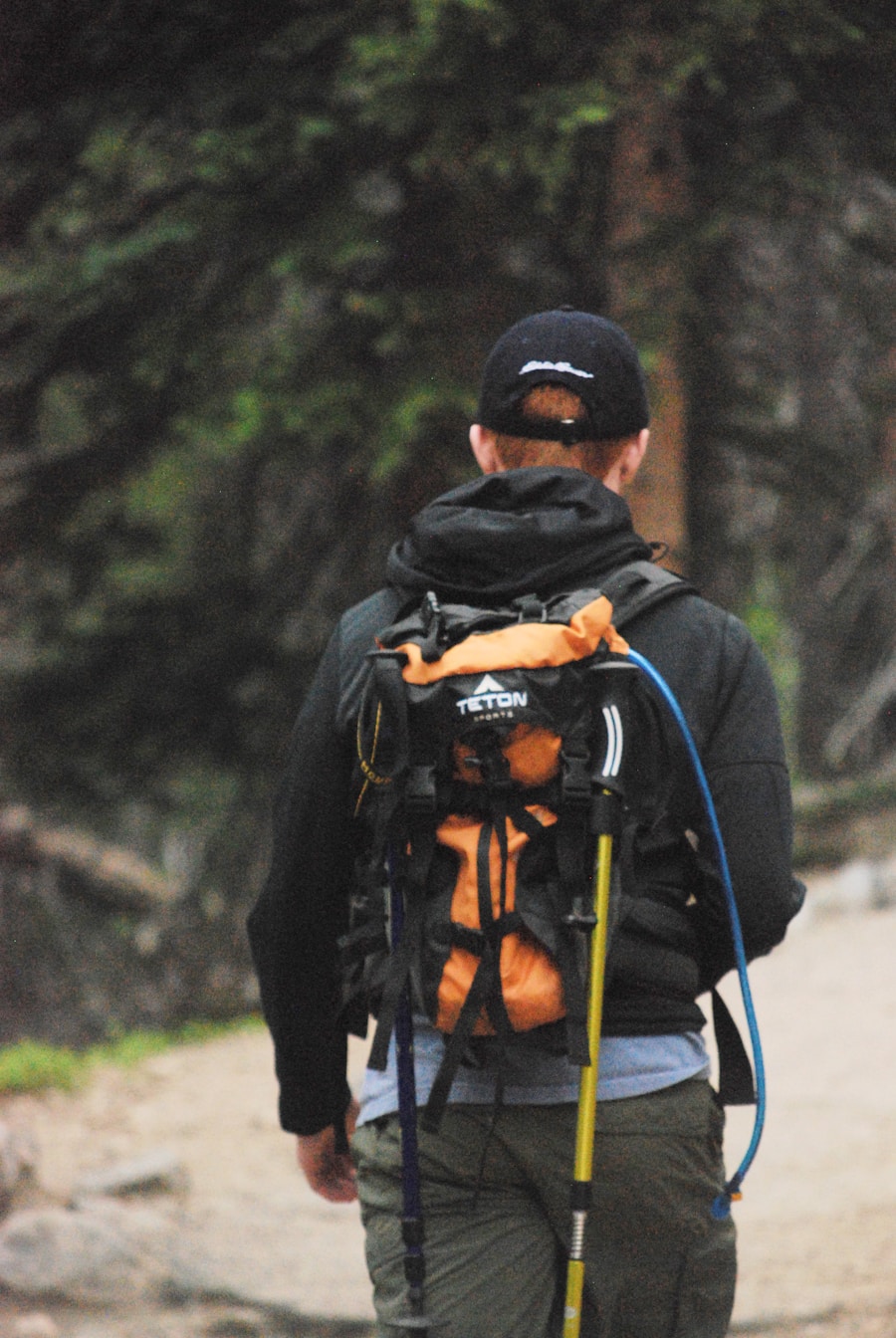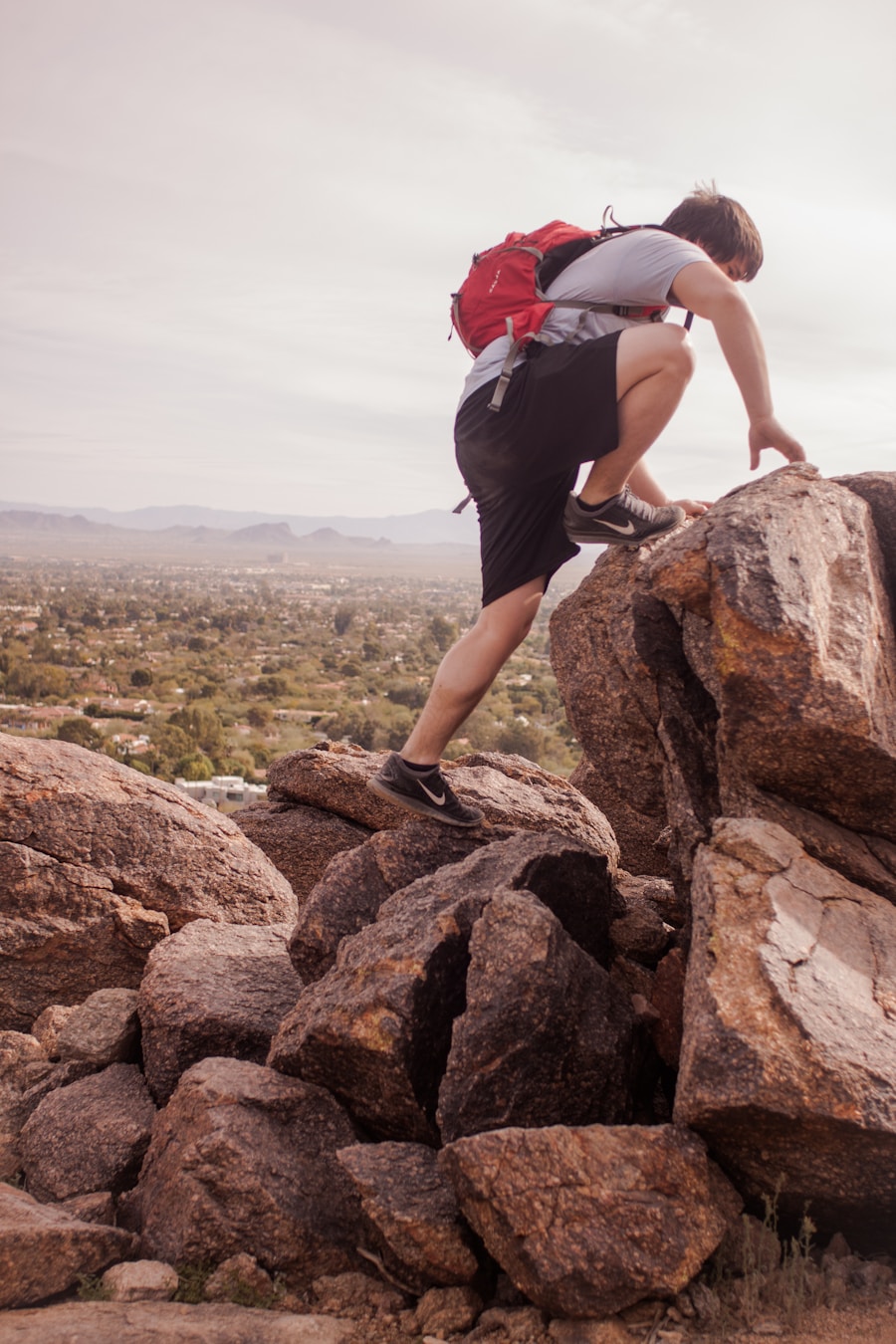Physical fitness plays a crucial role in the overall hiking experience, influencing not only performance but also safety and enjoyment. Hiking often involves traversing varied terrains, which can include steep inclines, rocky paths, and uneven surfaces. A well-conditioned body is better equipped to handle these challenges, reducing the risk of injury and fatigue.
When hikers are physically fit, they can maintain a steady pace, navigate difficult sections with greater ease, and enjoy the journey without being overly fatigued. This physical preparedness allows for a more immersive experience in nature, enabling hikers to appreciate the beauty around them rather than focusing solely on their physical limitations. Moreover, physical fitness contributes to mental resilience during hikes.
The psychological aspect of hiking is often underestimated; a fit individual is more likely to maintain a positive mindset when faced with obstacles such as steep climbs or inclement weather. Endurance and strength can bolster confidence, allowing hikers to push through discomfort and fatigue. This mental fortitude is essential for tackling longer or more challenging hikes, where the ability to persevere can make the difference between a successful outing and an early retreat.
Thus, physical fitness is not merely about the body; it encompasses the mind as well, creating a holistic approach to enjoying the great outdoors.
Key Takeaways
- Physical fitness is crucial for hiking to prevent injuries and enjoy the experience.
- Prepare your body for hiking by incorporating strength training and cardio into your fitness routine.
- Choose the right hiking gear, including proper footwear and clothing, to ensure comfort and safety.
- Building endurance and strength through regular exercise will help you tackle challenging hikes with ease.
- Incorporate flexibility and balance training to improve agility and reduce the risk of falls while hiking.
Preparing Your Body for Hiking
Preparing your body for hiking involves a multifaceted approach that includes building strength, enhancing endurance, and ensuring flexibility. One of the first steps in this preparation is to assess your current fitness level. Understanding your strengths and weaknesses can help tailor a training program that addresses specific needs.
For instance, if you find that your legs tire quickly on inclines, focusing on lower body strength through exercises like squats and lunges can be beneficial. Conversely, if you struggle with stamina on longer trails, incorporating longer walks or runs into your routine can help build the necessary endurance. In addition to strength and endurance training, it is essential to incorporate flexibility exercises into your preparation regimen.
Stretching not only helps prevent injuries but also improves overall mobility, which is vital when navigating uneven terrain. Activities such as yoga or dynamic stretching can enhance flexibility and balance, allowing for smoother movements on the trail. Furthermore, practicing specific movements that mimic hiking—such as step-ups or lateral lunges—can prepare your body for the unique demands of hiking.
By taking a comprehensive approach to physical preparation, you can ensure that your body is ready to tackle the challenges of the trail.
Choosing the Right Hiking Gear

Selecting appropriate hiking gear is fundamental to ensuring a safe and enjoyable experience on the trail. The right footwear is perhaps the most critical component of hiking gear. Hiking boots should provide adequate support, traction, and protection from the elements.
When choosing boots, consider factors such as the terrain you will be hiking on and the weight of your pack. For instance, lightweight boots may be suitable for well-maintained trails, while sturdier models are necessary for rugged terrains. Additionally, breaking in new boots before embarking on a long hike can prevent blisters and discomfort.
Beyond footwear, clothing choices also play a significant role in hiking comfort. Layering is key; wearing moisture-wicking base layers helps keep sweat away from the skin, while insulating layers provide warmth in cooler conditions. An outer shell that is both waterproof and breathable protects against rain and wind without trapping moisture inside.
Accessories such as hats, gloves, and sunglasses are also important for protection against sun exposure and temperature fluctuations. Ultimately, investing in high-quality gear tailored to your specific hiking conditions can enhance your overall experience and contribute to your physical well-being on the trail.
Building Endurance and Strength
| Exercise | Repetitions | Sets | Rest Time (seconds) |
|---|---|---|---|
| Push-ups | 15 | 3 | 60 |
| Squats | 20 | 3 | 45 |
| Plank | 60 | 3 | 30 |
| Deadlifts | 12 | 3 | 60 |
Building endurance and strength is essential for any hiker looking to tackle longer or more challenging trails. Endurance training typically involves aerobic activities that elevate the heart rate over extended periods. Activities such as running, cycling, or swimming can significantly improve cardiovascular fitness, which translates directly to better performance on hikes.
Incorporating interval training—alternating between high-intensity bursts and lower-intensity recovery periods—can also enhance endurance more efficiently than steady-state cardio alone. Strength training should focus on key muscle groups used in hiking: legs, core, and upper body. Exercises like deadlifts and squats target the major muscle groups in the legs, while planks and bridges strengthen the core, providing stability during uneven movements on the trail.
Upper body strength is equally important for using trekking poles effectively and carrying a backpack comfortably. Incorporating exercises such as push-ups and rows can help develop this strength. A balanced approach that combines both endurance and strength training will prepare you for the physical demands of hiking while reducing the risk of injury.
Incorporating Cardio into Your Fitness Routine
Cardiovascular fitness is a cornerstone of any effective hiking preparation program. Engaging in regular cardio workouts not only improves heart health but also enhances lung capacity and overall stamina—key components for tackling challenging hikes. Activities such as brisk walking, jogging, cycling, or swimming can be integrated into your weekly routine to build cardiovascular endurance.
For those who prefer outdoor activities, hiking itself can serve as an excellent form of cardio; however, supplementing it with other forms of exercise can provide variety and prevent monotony. To maximize cardiovascular benefits, consider incorporating interval training into your routine. This method involves alternating between periods of high-intensity effort and lower-intensity recovery periods.
For example, during a run or bike ride, you might sprint for 30 seconds followed by two minutes of walking or slow pedaling. This approach not only boosts cardiovascular fitness but also increases calorie burn in a shorter amount of time compared to steady-state cardio workouts. By diversifying your cardio routine with different activities and intensities, you can keep your workouts engaging while effectively preparing your body for the rigors of hiking.
Flexibility and Balance Training

Flexibility for Range of Motion
Flexibility allows for greater range of motion in joints and muscles, which is particularly important when navigating uneven terrain or steep inclines. Incorporating stretching routines into your fitness regimen can help improve flexibility over time. Dynamic stretches before a hike—such as leg swings or arm circles—can warm up muscles and prepare them for activity, while static stretches post-hike can aid in recovery.
Balance Training for Stability
Balance training is equally important for hikers, as it enhances stability on challenging trails where footing may be uncertain. Exercises such as single-leg stands or balance board workouts can improve proprioception—the body’s ability to sense its position in space—thereby reducing the risk of falls or injuries on the trail.
Yoga for Flexibility and Balance
Yoga is another excellent way to develop both flexibility and balance; poses like tree pose or warrior III challenge stability while promoting muscle elongation. By prioritizing flexibility and balance training in your fitness routine, you will enhance your overall hiking performance and reduce the likelihood of injury.
Nutrition for Hiking
Nutrition plays a pivotal role in preparing for hikes and sustaining energy levels during outdoor adventures. A well-balanced diet rich in carbohydrates, proteins, fats, vitamins, and minerals provides the fuel necessary for physical activity. Carbohydrates are particularly important as they serve as the primary energy source during prolonged exercise; whole grains, fruits, and vegetables should be staples in a hiker’s diet leading up to an outing.
Additionally, incorporating lean proteins—such as chicken, fish, beans, or legumes—supports muscle repair and recovery after strenuous hikes. On the trail itself, having a strategic approach to nutrition can make a significant difference in performance and enjoyment. Packing lightweight snacks that are high in calories but easy to carry—such as nuts, energy bars, or dried fruits—can help maintain energy levels without weighing down your pack.
Hydration is equally critical; drinking water regularly throughout the hike prevents dehydration and maintains optimal performance levels. Some hikers may also benefit from electrolyte-replenishing drinks or tablets during longer excursions to replace lost minerals through sweat.
Recovery and Rest for Hiking Fitness
Recovery is an often-neglected aspect of fitness that is essential for long-term success in hiking endeavors. After strenuous hikes or intense training sessions, allowing time for recovery helps prevent overuse injuries and promotes muscle repair. Active recovery methods—such as light walking or gentle stretching—can facilitate blood flow to sore muscles without placing additional strain on them.
Additionally, incorporating rest days into your training schedule allows your body to recuperate fully before tackling new challenges. Sleep also plays a vital role in recovery; quality sleep supports muscle repair and cognitive function essential for decision-making on the trail. Establishing a consistent sleep schedule can enhance overall recovery processes and improve performance during hikes.
Furthermore, practices such as foam rolling or massage therapy can alleviate muscle tightness and promote relaxation after intense physical activity. By prioritizing recovery strategies alongside training efforts, hikers can ensure they remain fit and ready for their next adventure in nature’s playground.
If you’re looking to get in shape for hiking, you may also want to consider investing in some essential gear for your outdoor adventures. One useful item to have is a rechargeable hand warmer to keep your hands warm during chilly hikes. Another important piece of equipment is a solar-powered camping lantern to light up your campsite at night. Additionally, you can stay organized on your trips with packing cubes to efficiently pack and unpack your belongings. These items can enhance your hiking experience and make your outdoor adventures more enjoyable.
Love travel? Join Our Facebook Community For More Tips.
FAQs
What is the best way to get in shape for hiking?
The best way to get in shape for hiking is to incorporate a combination of cardiovascular exercise, strength training, and flexibility exercises into your fitness routine. This will help improve your endurance, strength, and flexibility, which are all important for hiking.
How often should I exercise to get in shape for hiking?
It is recommended to exercise at least 3-5 times per week to get in shape for hiking. This should include a mix of cardiovascular exercise, strength training, and flexibility exercises to improve overall fitness and prepare your body for the demands of hiking.
What are some specific exercises that can help me get in shape for hiking?
Specific exercises that can help you get in shape for hiking include walking, hiking on inclines, stair climbing, squats, lunges, calf raises, core exercises, and yoga or stretching exercises. These exercises can help improve cardiovascular endurance, leg strength, and flexibility, which are all important for hiking.
How can I prevent injuries while getting in shape for hiking?
To prevent injuries while getting in shape for hiking, it is important to start slowly and gradually increase the intensity and duration of your workouts. It is also important to listen to your body, warm up before exercising, and use proper form during exercises. Additionally, wearing appropriate footwear and using hiking poles can help reduce the risk of injuries while hiking.
Are there any specific dietary recommendations for getting in shape for hiking?
To get in shape for hiking, it is important to maintain a balanced and nutritious diet that includes a mix of carbohydrates, protein, and healthy fats. It is also important to stay hydrated by drinking plenty of water and electrolyte-rich beverages, especially during longer hikes. Consuming a diet rich in fruits, vegetables, whole grains, and lean proteins can help support your fitness goals for hiking.
